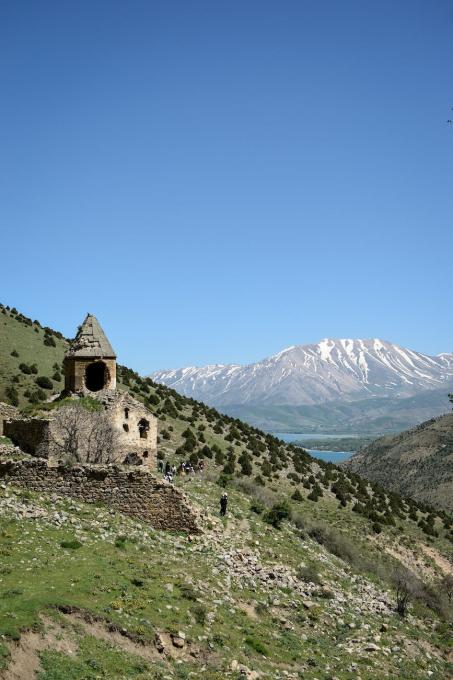
From Noravank, I headed up the Selim Pass towards Lake Sevan. This road is probably at its best in the springtime when the wildflowers bloom in the alpine meadows. This was formerly part of the Silk Road and near the highest point, at around 2410 metres, is a caravanserai, the Selim or Orbelian caravanserai. It was built in 1332 by prince Chesar Orbelian to accommodate weary travellers and their animals as they crossed the Vayots Dzor region. It is the best preserved caravanserai in the entire country and made of blocks of basalt which make the interior dark even during the day. There’s one long, single hall divided into three distinct areas. Animals rested in the narrow aisles to the left and right of the main hall. Between the pillars were stone troughs for the animals, and in the corner was a pool of water. Travellers slept in a separate room built at the end of the narrow aisles on the western side. Inscriptions in Armenian, Arabic, and Persian are etched on various parts of the building.
Heading northwards, the road soon starts a descent and passes through villages close to Lake Sevan. One such village is Noratus or Noraduz, famous for its mediaeval cemetery with the largest number of khachkars in Armenia. The local ladies are very keen for visitors to buy samples of their needlework. Other locals will tell you stories. According to them, at the time of Timur’s or Tamerlane’s invasion of the country, the villagers placed helmets on top of the khachkars and leaned swords against them. From a distance, the khachkars looked like armed soldiers holding a defensive position and Tamerlane’s army retreated. As a commander, Tamerlane never lost a battle and the idea his soldiers would retreat from a group of motionless stones is silly.
A more believable story is about the 19th-century monk named Ter Karapet Hovhanesi-Hovakimyan, from a monastery near the village. He conducted burial services at Noraduz and built himself a small cell. When he was 90 years old, he asked his brother monks to bury him alive. His last words encouraged fearful visitors to his tomb to bring water with them in a container and either drink the water or wash themselves before smashing the container. When they broke the container, fear would abandon them. Nowadays, I’m not sure people drink water at the grave or even wash themselves there, but they certainly do smash glass containers as there are many pieces of glass scattered about by newly fearless visitors.
Continuing with the theme of water, located 1900 metres above sea level and with a backdrop of mountain peaks, Lake Sevan is famous for the variations in the water’s colour that can range from a deep blue to turquoise. Sevan is the largest lake in the Caucasus region, covering an area of 940 square kilometres, and is one of the largest fresh-water, high-altitude lakes in the world. I stayed by the shore of the lake in a Hotel called The Blue Sevan. One person’s description of this hotel was that it was like Chernobyl without the radiation. The hotel is a Soviet-era art déco structure originally designed for government ministers, so it is over-the-top in terms of scale. The lobby includes a grand piano. Some rooms contain large amounts of furniture, for example two double beds, a single bed, and a three-piece suite. It is certainly very comfortable and clean and almost devoid of guests. The early morning views of the mist on the turquoise water and the reflections of the mountains are beautiful and photogenic. The hotel served a small buffet breakfast in a large room in an annex about 100 metres from the main building. There are paths in the surrounding woods and a shingle beach. Staying in this hotel is an experience I would encourage you to take. From the beach you can see Sevanavank Monastery, prominent on a small hill.
According to an inscription in one church, Princess Mariam, the daughter of Ashot I, founded the monastery of Sevanavank in 874 when Armenia was struggling to free itself from Arab rule. The monastery was strict and intended for those monks from Etchmiadzin who had sinned.
